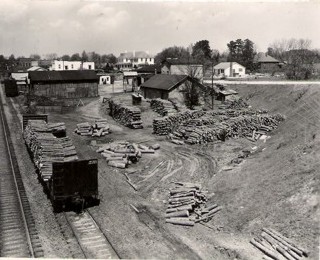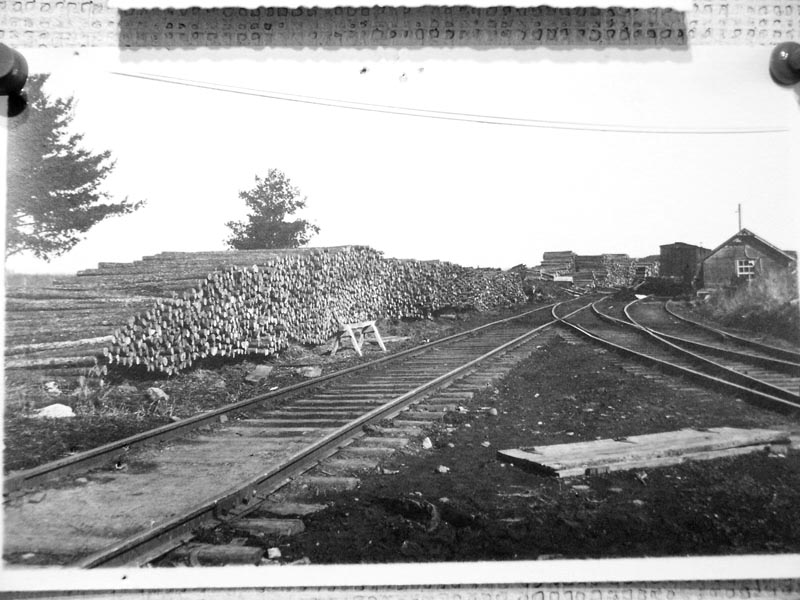Does anyone have photos or other good information about pulpwood loading yards? My grandmother lived about 200 feet from the KCS mainline in southwest Arkansas, and her first cousin operated a very small pulpwood loading facility adjacent. Basically, the KCS would send a local to drop-off bulkhead flat cars on the spur, and her cousin would use some type of a loader device to pull the “sticks” off the trucks that came in from the woods. He’d load the pulpwood on the flat cars, and then the local would pick-up loaded cars every few days. He’d have no more than about 2-3 flats on the spur at any one time and he did all the work himself, from what I can recollect. Of course, the whole operation shut down around 1980 when the paper mills started going to whole log processing and everything was trucked straight from the woods. Any other comments or photos, especially, would be great.
One source to search for pulpwood loading photos would be paper manufacturing books and pamphlets from the 1950’s and 1960’s,
Search stock photography and state historical society photo collections on-line for paper and pulpwood.
Andrew
What I saw in Reform, Ala. was a process in which the truck that brought the wood to the woodracks (woodracks looked like bulkhead flats, but had a floor that sloped towards the centerline of car so that the natural movement of the load would be towards the center) had a winch with an arm in the center of the truckbed. This winch was used to pick a bundle of pulpwood up and then place it on the rack.
There was some pulp wood loading in Upstate NY and nearby PA several years ago on then Conrail at Deposit, NY and Emporium, PA that I saw. Trucks with loads would be unloaded either by its own fingers or by an on ground loader between truck and railcar.
Look up paper industry pulpwood yard on yahoo in the images and you will find this.
http://www.state.sc.us/forest/scindust.htm

http://www.corbisimages.com/Enlargement/Enlargement.aspx?id=IH107468&caller=search
Look at that Pulpwood lumber yard.
Seeing this picture with the cordwood (as some called it) lying loose reminds me that whenever I saw a man loading a woodrack in my hometown, in South Carolina, he would be moving it from his truck to the car stick by stick.
Also, note that the outer end of each stick on the car is higher than the inner end–definitely the floor of the car was not flat.
Here are some comments on the short history of forest industry.
“Lightwood” is not light in weight; the high resin content makes it heavy. A piece of “lightwood” or “lighterwood,” as some call it, can be lit and used as a torch.
“Turpentining” was a way of living for some. I do not know how the “turpentiners” fared the rest of the year.
A bow to the first contributor who can give the correct pronunciation of “Horry,” as in “Horry county.”
Slabs were truly good for firewood, especially after they were cut into fireplace or stove length. Also, after they had been so cut, they were useful in building forts (my personal experience as a boy).
I’d guess it’s been 30 or more years since I last saw pulpwood being loaded on woodracks here in NW Louisiana. But until about a year ago I’d often see whole unit trains of the old bulknead woodrack cars running north on the KCS at Shreveport carrying not pulpwood but large slabs of steel. All the cars in these trains had either KCS or SR reporting marks. I’d see these trains about twice a month running loaded northbound and returning empty southbound. Obviously I didn’t see each and every movement so I’m sure they ran more frequently than that.
I’d estimate the steel slabs they carried to be about 4-5 ft wide, 20 ft long and a foot to 18 in thick. They were usually loaded six slabs/car, four on the deck of the car and two more on top of these four. I never learned the origin or destination of these loads but assumed it was foreign steel coming into the country from either Mexico or being off loaded from a ship at Port Arthur. The slabs were likely destined for a rolling mill in the upper mid-west.
I haven’t seen any of these trains lately so they’ve either been discontinued or, if they’re still running, now come through in the wee hours of the morning when I wouldn;t have a chance to see them.It was nostalgic to see these rusty, near 50 years old relics still in service even though they were no longer carrying pulpwood.
Mark
Mark–yep, it was about 30 years ago that they shut-down my cousin’s loading operation. By the way, since you’re from the Shreveport area, do you know where Ravanna, AR is? That’s where I’m referring to. Thanks for sharing about the steel loads–I loved seeing pulpwood, but that’s a bygone era now, I think.
As I remember the loading in both Deposit, NY and Emporium, PA it was done right from truck to railcar at team tracks. Deposit’s team track was inside and part of the old yard on the westbound track at the station site (site of ceremonial first spade of Earth turned for the building of the Erie RR). In Emporium,the team track ran parallel to the east west Route 6 on the west side of town between the town and Emporium Jct.
O-ree
I kind of tried the shotgun approach on a google search. I did see a few good photos.
I saw a dozen or more photos of pulpwood loading and unloading equipment.
Rgds IGN
That sounds a lot like the recycled aluminum slabs(ingots?) that I used to see on the ex-Georgia Railroad. They were silver in color.
Jay
